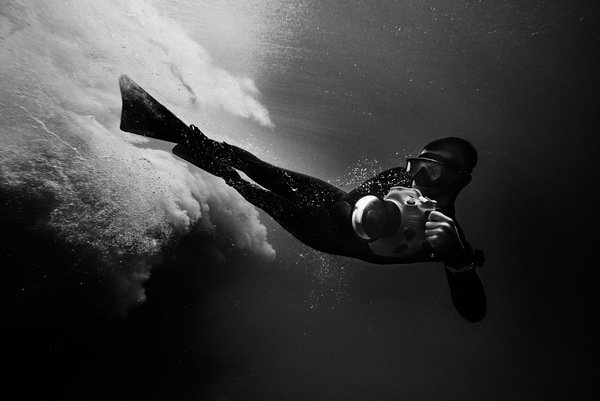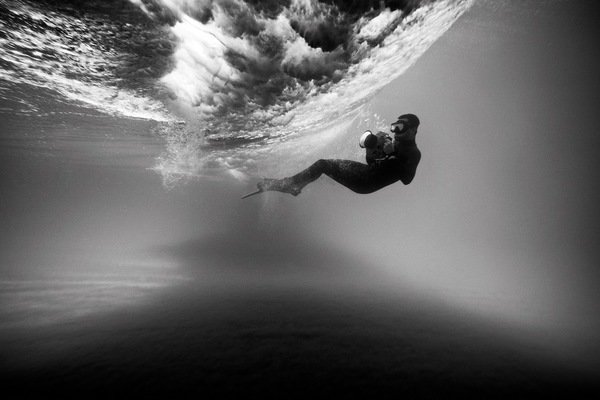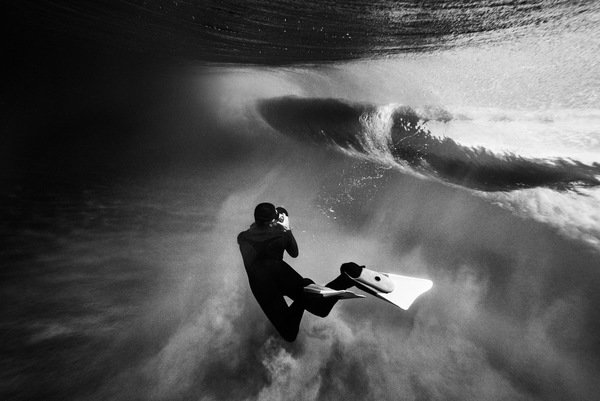THE HOURGLASS
Artist Background:
Chris DeLorenzo Interview By Alyssa Shapiro
August 18, 2016
“Under the surf in LA,” is where the photographer Chris DeLorenzo has essentially set up his studio. Before the majority of us have finished our second cup of coffee and first round of emails, DeLorenzo is already on his way back out of the ocean, back toward the less tempestuous dominion of the shore, having taken an entirely new set of images from his ever-changing vantage point beneath the ocean’s waves — and having essentially completed his workout for the day. From 6:30 to 10 a.m., wielding a roughly 15-pound Nikon D4S protected by waterproof casing, diving into an unpredictable sea, DeLorenzo ventures out to capture a perspective of the water, in all its power and beauty, that is often unseen.
“Not even the surfers are seeing this,” muses DeLorenzo, and he feels that they should — hence the camera.
Pointing to the turbulent center of the photograph chosen for this Whisper Edition, DeLorenzo describes the unpredictably of getting the shot:
“If I’m here, where this storm is, I would have gotten destroyed,” he says. Instead, to his success, he dives under the waves with the help of fins and a mask (but no snorkel), twists, “dances” to line up properly with the wave, dodging crashing water, and turns at just the right angle to capture what he sees. For this particular shot, he swam “under the wave, looking back at it,” and successfully captured the barrel of the wave as it cycled, shooting water back upward toward the sky.
Getting tossed around badly in the ocean with regularity (“probably every time I’m out there,” the photographer says,) he’s dealt with his camera getting ripped out of his hands and smashed into the sand, and similar near misses with his head. But he understands the gravity of proper respect for the ocean, knowing how to listen to it, so he can decide when to swim back toward shore and onto land for the day. “No photo is worth it, you have to know when you can push it. You have to know the ocean pretty well,” he says.” As for knowing when to first dive in, DeLorenzo says, “You can’t control it, it’s not like a car. You see your opening, and when there aren’t so many waves, you swim as hard as you can out there, and once you’re out there, you feel how close you are to where the waves are breaking.” And yet: “I’ve definitely gotten cuts and bruises.”
“The water is this certain color blue in Northern Malibu,” DeLorenzo says, which is why he has such an affinity for that particular stretch of ocean, as opposed to the greenish tinge much of the surrounding ocean seems to carry. Perhaps it has to do with purer sand, or water freer of pollution.
Early mornings, chilly, tough waters, and breath-holding aside, for viewers of DeLorenzo’s work, he’s doing his best to make sure that at least visually, our experiences are as close to his as possible. Explaining, DeLorenzo says, “The canvas was there, and I’m not saying my photos are post-processed to a million degrees, but the ocean gave me the canvas to then dial in that color blue — the water was so clear so that I was able to portray what I saw. What I shoot in the camera is not what I see,” but with the help of Photoshop, he can bring up the colors to the best of his memory. He’s doing his best to show us in photographs the beauty he sees in the world, which is why color and light play such a huge role in his work.
“Right before the sun comes up, and right before the sun goes down, everything glows,” and so are favorite times to take out his camera. “Even certain places have certain colors.” For instance, the emerald green on the coast of Ireland, and then there’s a specific, hard-to-categorize green in Sri Lanka that seems to nag at DeLorenzo’s creative heartstrings. “I’d never been attracted to the color green until I was there. It’s very green-yellow, very earth-toned and organic. And it was the ocean, again, just 30 hours away.”
Closer to home, places that inspire DeLorenzo include the Imperial Sand Dunes of Brawley, California, close to the Mexican border, and further north, Fossil Falls off the 395 freeway. Road trip, anyone?


